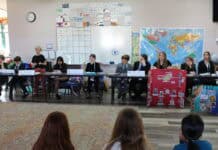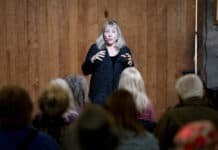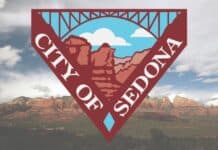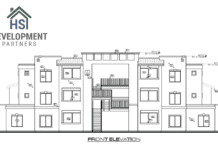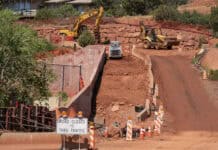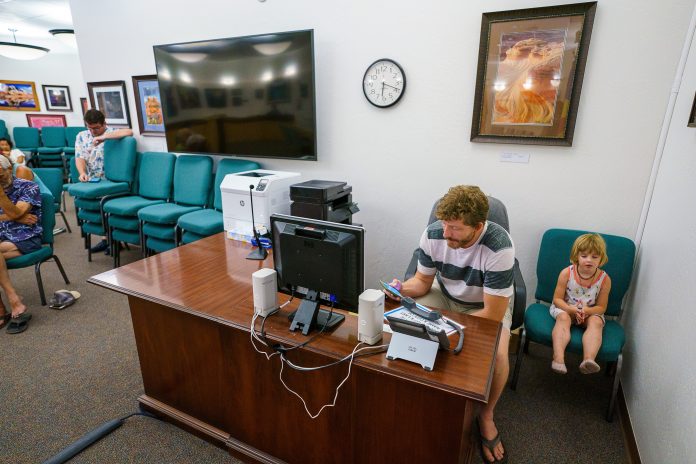
*The text of the mask proclamation is included below the story
For decades it’s been common to see signs on the front of businesses that state “No shoes. No shirt. No service.” These days, however, many will be adding a new requirement to that list — masks.
The Sedona City Council spent more than four hours on Tuesday, June 23 discussing whether or not to join dozens of other Arizona cities and counties that, at the least for the time being, are requiring masks to be worn in public. In the end, Mayor Sandy Moriarty chose to require them in Sedona.
A proclamation was signed by Moriarty on Wednesday, June 24, and went into effect at 11:59 p.m. on Thursday, June 25.
Moriarty said she’s received between 300 to 400 emails on the matter and appreciates the input.
“People are passionate about this issue and I’m one of them,” she said at the end of the meeting, which concluded around 10:15 p.m. “I’ve tried my best to follow what purports to be facts about this novel virus. That’s a problem because it is a novel virus and there’s a lot we don’t know, still, to this day. I’ve seen many, many scientists admit that, which is why I do still consider it an emergency.”
She went on to add, “I think it’s important that we realize that when you wear a mask, it isn’t to protect you from getting the virus, it’s to protect you from giving it to someone else.”
The proposed mandate came on the heels of the number of Arizona’s COVID-19 cases and deaths spiking in the last two weeks as well as on-going recommendations by the Centers for Disease Control and Prevention and the World Health Organization for wearing masks.
While an official vote was not taken, when expressing their views on the matter all on council but John Currivan were in favor of a proclamation.
Currivan, who encouraged the use of masks, said he was opposed because he questions the effectiveness and safety of some masks. He also said Arizona Gov. Doug Ducey’s executive order allows a city to mandate masks “based on conditions in its jurisdiction.” He doesn’t believe that the current conditions in Sedona justify a proclamation mandating masks.
Council members learned late in the meeting that the item was for discussion only and that a vote would not be taken. This came as a surprise to some in attendance.
“It was known that the mayor was seeking direction on issuing a proclamation,” City Manager Justin Clifton said the next day. “Since the authority to issue an emergency proclamation is given solely to the mayor, there was no reason to have a vote or review a draft proclamation. The goal of the meeting was to get input from council so that she could review and amend a draft proclamation accordingly. This is consistent with the approach we take when council gives direction to staff.”
Currivan later asked about a draft proclamation that Moriarty had mentioned and whether council would be able to review it before giving input. He also asked if anyone else on council had seen it.
The next morning, City Attorney Robert Pickels said the draft proclamation was not circulated to council, but that he had sent it to Clifton and the mayor just prior to the meeting.
In all, 23 members of the public spoke via Zoom from the Council Chambers, including some who took part in a small protest near city hall earlier that afternoon.
All were opposed to wearing masks for a variety of reasons including health concerns, low COVID-related cases and deaths in Sedona, infringement upon their civil liberties, the effectiveness of masks, concerns it will lead to mandated vaccinations and going against the will of the residents.
One of those opposed was Taylor Carver, who said he represents 1,100 people who signed a petition against the mandatory use of masks.
He pointed out that Yavapai County has had around 500 reported cases and seven deaths during the pandemic.
“There’s 260,000 people here in Yavapai County, so this virus has not affected 99.9% of the population,” he said. “This isn’t much of a pandemic as far as I’m concerned, at least in
our town of Sedona and our county of Yavapai. We’ve sustained minimal effects of COVID without mandatory masks. In fact, the majority of people here in Sedona do not wear masks in public and this goes for tourists as well.”
Later in the meeting, Clifton said the city received public input from a variety of sources including hundreds of emails sent to the city and council. Several council members said the majority of emails they have received were in favor of the proclamation — in a few cases by nearly a 3-to-1 margin.
Clifton referenced a Sedona Chamber of Commerce survey in which 553 people responded. Of those, 65% agreed that businesses in Sedona that deal with the public should require employees to wear masks. Sixty percent said they believe that persons entering a private business should be required to wear a mask. And 51% agreed that masks should be worn outdoors when six feet of distancing is not available. Finally, 36% agreed that city or county governments should not mandate masks for everyone.
The city posted its own survey on Facebook. Clifton pointed out that it was impossible to limit it to residents, which he said may account for the 4,900 people who responded. Of those, 2,700 people, or 56%, said they do not support a mandate and 2,200 making up 44% were in favor.
In terms of enforcement, Clifton said education will be the preferred approach but if someone continues to defy the order, citations by police will be issued. On those same lines, he said officers will be reactive rather than proactive, meaning that they will refrain from seeking out those not wearing masks but will respond to calls.
“We’re not taking a heavy-handed approach,” Clifton said.
On those lines, Sedona Police Chief Charles Husted said, “We’d prefer not to have to issue a citation. Instead, our objective is to lead with education and provide information to those we contact in relation to the proclamation. This is the same effective approach that we used during the release of the Governor’s early Executive Orders. The goal is to safeguard the health of everyone, which will require compassion and kindness on behalf of all involved. When possible, our staff will have masks on hand to provide to folks who do not have one.”
Moriarty’s order, which cites Arizona Revised Statute §26-317, states that failure to comply would constitute a Class 1 misdemeanor and could result in six months in jail or a fine of up to $2,500.
Sedona joins a growing list of Arizona cities that are now requiring the wearing of masks in public including Phoenix, Scottsdale, Tucson and Tempe. Closer to home, the mayors of Cottonwood and Clarkdale have also imposed a mandate — Cottonwood Mayor Tim Elinski doing so after council voted 4-3 not to impose a mandate — while others like Bullhead City, Lake Havasu City, Prescott and Prescott Valley have enacted only recommendations in regard to the wearing of masks.
Sedona Mask Proclamation
Sedona Mayor Sandy Moriarty orders that effective Thursday, June 25, at 11:59 p.m., every person within the jurisdiction of the city of Sedona who is five [5] years of age or older is required to cover his or her nose and mouth with a face covering when in a public place where continuous physical distancing is difficult or impossible. Businesses whose employees interact with the public must require employees to wear face coverings.
Definitions:
— A “face covering” means a covering made of cloth, fabric, or other soft or permeable material that covers only the nose and mouth and surrounding areas of the lower face. A covering that hides or obscures the wearer’s eyes or forehead in addition to the nose and mouth is not a face covering. Examples of face coverings include a scarf or bandana; a neck gaiter; a homemade covering made from a T-shirt, sweatshirt, towel, or other fabric held on with rubber bands or otherwise; or a face mask, which need not be medical grade. A face covering may be factory-made or handmade and improvised from ordinary household materials. The face covering should be comfortable, so that the wearer can breathe through the nose and does not have to adjust it frequently, so as to avoid touching the face.
— “Public place” means indoor spaces that are accessible to the public such as grocery stores, retail stores, pharmacies and health care facilities, restaurants and bars, gyms and similar facilities, and any other spaces where the public can enter; outdoor public spaces where people congregate, including but not limited to areas where persons stand in lines for entering an establishment; and in or on public transportation vehicles or any other vehicle for hire including but not limited to trolleys and tour operations.
— “Physical distancing” means keeping six feet of distance between individual persons who are not of the same household.
— “Person” means any person, regardless of whether the person is an employee, customer, vendor, invitee or other.
Exceptions:
Face covering is not required under the following circumstances:
— When a person is in a personal office or similar space [a single room] where others are not present as long as the public does not regularly visit the room.
— For any person who falls under CDC guidance for those who should not wear a face covering, including but not limited to any child under the age of 5.
— For any person who cannot wear a face covering because of a medical condition, mental health condition or developmental disability, or who is unable to remove the face covering without assistance. A person who cannot wear a face covering because of a medical condition is not required to produce medical documentation of the condition, provided that an employer may require such documentation from an employee in accordance with state and federal law.
— For restaurant patrons while they are eating or drinking at their table or seating area.
— For public safety employees and/or emergency responders, when wearing the face covering would interfere with or limit their ability to carry out their duties or functions; and for any person acting at the direction of a public safety employee.
— In settings where it is not practicable or feasible to wear a face covering due to the nature of the services provided, such as when receiving dental services, medical treatments, personal hygiene services, or while swimming.
— For persons exercising outdoors, or while walking or exercising with other persons of the same household, as long as physical distancing from others is maintained.
Enforcement:
In compliance with Executive Order 2020-40, enforcement of this Emergency Proclamation shall focus first on education and providing guidance issued by the CDC and Arizona Department of Health Services to promote health and safety as well as to further contain the spread of COVID-19. Individuals shall also be given an opportunity to comply with the Emergency Proclamation before any enforcement action is taken. Continued failure to comply with the Emergency Proclamation is a misdemeanor under A.R.S. § 26-317.
Physical distancing recommendations of the CDC remain the most effective tool to mitigate the spread of COVID-19; hence, face coverings are not a replacement for adhering to physical distancing and hygiene practices.
The City Manager, or his designees, shall take all appropriate action needed to alleviate and mitigate the effects of a possible COVID-19 outbreak within the city of Sedona, and to take any and all action, including such lawful actions necessary to respond to this emergency.
The proclamation of emergency and the orders included herein shall be effective immediately upon filing with the city clerk and shall remain in effect as provided above or until withdrawal of the proclamation of emergency is similarly filed with the city clerk.


